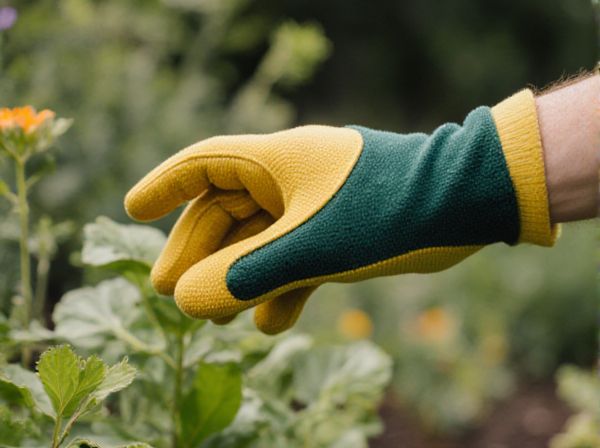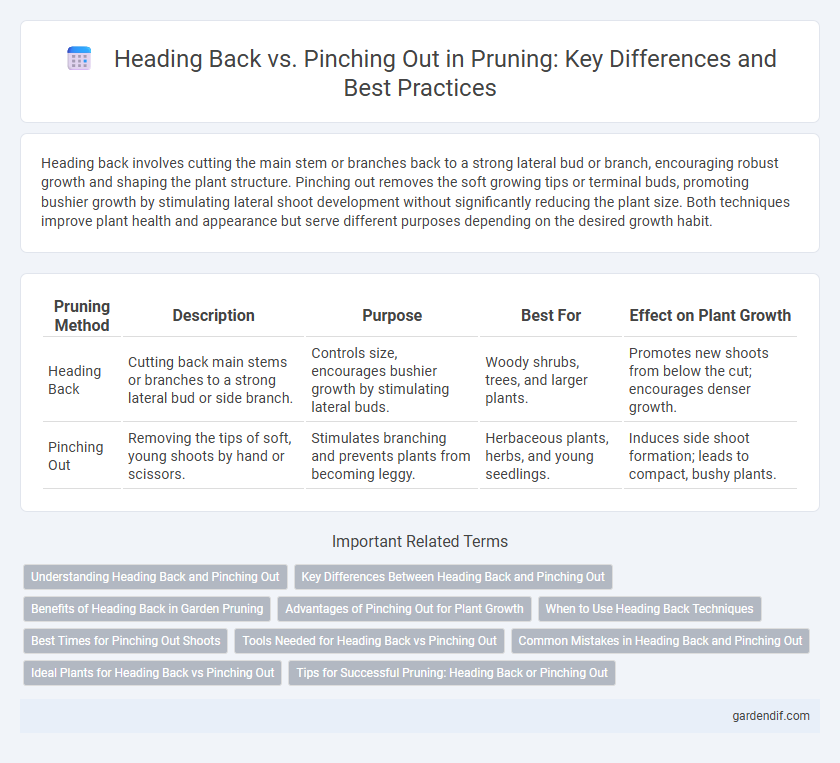
Heading back vs pinching out Illustration
Heading back involves cutting the main stem or branches back to a strong lateral bud or branch, encouraging robust growth and shaping the plant structure. Pinching out removes the soft growing tips or terminal buds, promoting bushier growth by stimulating lateral shoot development without significantly reducing the plant size. Both techniques improve plant health and appearance but serve different purposes depending on the desired growth habit.
Table of Comparison
| Pruning Method | Description | Purpose | Best For | Effect on Plant Growth |
|---|---|---|---|---|
| Heading Back | Cutting back main stems or branches to a strong lateral bud or side branch. | Controls size, encourages bushier growth by stimulating lateral buds. | Woody shrubs, trees, and larger plants. | Promotes new shoots from below the cut; encourages denser growth. |
| Pinching Out | Removing the tips of soft, young shoots by hand or scissors. | Stimulates branching and prevents plants from becoming leggy. | Herbaceous plants, herbs, and young seedlings. | Induces side shoot formation; leads to compact, bushy plants. |
Understanding Heading Back and Pinching Out
Heading back involves cutting a branch or stem back to a bud or lateral branch to encourage bushier growth and more flowering, promoting plant health and shape. Pinching out is the process of removing the very tip of a new shoot to stimulate side branching and denser foliage, commonly used on herbaceous plants for a fuller appearance. Understanding the differences helps gardeners apply the correct technique for specific plant types and desired growth outcomes.
Key Differences Between Heading Back and Pinching Out
Heading back involves cutting a branch or stem back to a bud or lateral branch to encourage dense growth, while pinching out removes the growing tip of a shoot to promote bushier development without significantly reducing stem length. Heading back typically results in stronger, more vigorous regrowth and is used to control plant shape and encourage flowering. Pinching out is less severe, often used on herbaceous plants to maintain compactness and increase branching without major impact on overall plant size.
Benefits of Heading Back in Garden Pruning
Heading back in garden pruning promotes vigorous growth by cutting branches to a bud or lateral branch, encouraging denser foliage and improved plant shape. This method speeds up the development of strong, healthy stems, enhancing flowering and fruit production. Compared to pinching out, heading back offers more control over the plant's structure, leading to a well-balanced and aesthetically pleasing garden.
Advantages of Pinching Out for Plant Growth
Pinching out promotes bushier plant growth by stimulating lateral branching through the removal of apical buds, which redirects energy to side shoots. This technique enhances airflow and light penetration within the plant canopy, reducing the risk of diseases and improving overall plant health. It also encourages the development of more flowers and fruits, leading to a higher yield compared to heading back.
When to Use Heading Back Techniques
Heading back techniques are ideal for rejuvenating overgrown plants by cutting stems back to a strong, lateral bud or branch, encouraging vigorous new growth. This method is commonly used in late winter or early spring before active growth begins to prepare plants for the upcoming season. Employ heading back when you want to control plant size, promote bushier growth, or remove damaged or leggy stems effectively.
Best Times for Pinching Out Shoots
Pinching out shoots is most effective during early spring when new growth is tender and actively elongating, promoting robust lateral branching. Best practice involves pinching just above a leaf node to stimulate growth nodes below and enhance plant fullness. Avoid late-season pinching to prevent stimulating new growth vulnerable to frost damage.
Tools Needed for Heading Back vs Pinching Out
Heading back requires sharp pruning shears or loppers to make clean, precise cuts on thicker stems, while pinching out can be effectively done using just fingers for young, tender shoots. For heading back, sterilized tools help prevent disease and ensure healthy regrowth, whereas pinching out demands no special equipment but careful hand technique. Proper selection of tools optimizes plant health and growth control during pruning.
Common Mistakes in Heading Back and Pinching Out
Heading back often results in excessive removal of growth, which can weaken plants and reduce flowering potential, while pinching out is commonly misapplied by cutting too close to the main stem, risking infection or damage. Both practices frequently suffer from improper timing and incorrect cutting angles, leading to poor wound healing and stunted growth. Understanding precise cuts and optimal growth stages is key to avoiding these prevalent pruning mistakes.
Ideal Plants for Heading Back vs Pinching Out
Ideal plants for heading back include woody shrubs and trees like roses, hydrangeas, and fruit trees that benefit from stronger structure and controlled growth. Pinching out suits soft-stemmed annuals and perennials such as coleus, basil, and chrysanthemums, where encouraging bushier foliage and more blooms is desired. Selecting the proper technique ensures optimal shaping and healthy plant development based on species characteristics.
Tips for Successful Pruning: Heading Back or Pinching Out
Heading back involves cutting stems back to a bud or branch to promote bushier growth, while pinching out removes the growing tips by hand to encourage branching without heavy cuts. For successful pruning, use clean, sharp tools to prevent disease, prune during active growth periods, and focus on removing weak or overcrowded stems. Regularly assess plant responses and adjust pruning methods to maintain the desired shape and health.
Heading back vs pinching out Infographic

 gardendif.com
gardendif.com